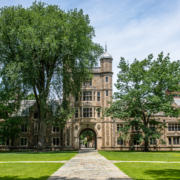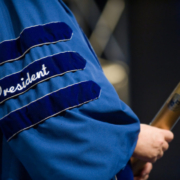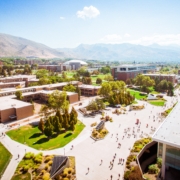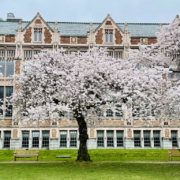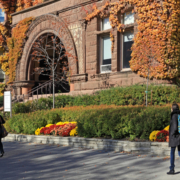Appointments
Albany State University Appoints Interim President
Dr. Lawrence Drake II has been selected to serve as Interim President of Albany State University. He takes over the role from President Marion Fedrick who left to accept the position of Executive Vice President at Georgia State University. Drake most recently served as Interim President for Bethune-Cookman University.
Read more
Albright College Selects Interim President
Dr. Debra Townsley has been selected to serve as Interim President of Albright College. She succeeds President Jacqueline Fetrow who announced her resignation in May. Townsley is the former President of William Peace University.
Read more
Briar Cliff University Names 13th President
Dr. Matthew J. Draud has been selected to serve as President of Briar Cliff University. He succeeds Interim President Steven Freeman who has led the school after President Patrick Schulte resigned in 2023. Draud arrives from McMurray University where he was the Vice President of Academic Affairs.
Read more
Bryn Mawr College Appoints 10th President
Dr. Wendy Cadge has been selected to serve as President of Bryn Mawr College. She was appointed following President Kim Cassidy who served in the role for 11 years. Before being appointed as President, Cadge served as Dean of the Graduate School of Arts and Sciences at Brandeis University.
Read more
Bucks County Community College Selects 6th President
Bucks County Community College has named Dr. Patrick M. Jones to serve as President. He previously served as Chancellor of Penn State Schuylkill since 2019. Jones succeeds President Felicia Ganther who stepped down due to family illness.
Read more
Cal State Fullerton Names 9th President
Dr. Ronald Rochon has been selected to serve as the President of California State University Fullerton. He arrives from the University of Southern Indiana where he served as President. He succeeds Interim President Sylvia Alva who has served in the role since 2023.
Read more
Christ College of Nursing and Health Sciences Names President
Dr. Amy Demelo-Wutke has been named as President of Christ College of Nursing and Health Sciences. She takes over the helm after the retirement of President Gail Kist-Kline. Demelo-Wutke most recently served as President of Cox College since 2017.
Read more
Claremont Graduate University Names Interim President
Tim Kirley has been chosen to serve as Interim President of Claremont Graduate University. He succeeds President Len Jessup who served in the role for six years. Kirley served as Chair of CGU’s Board of Trustees for the last six years.
Read more
Colby-Sawyer College Names Alumna as Interim President
Dr. Laura A. Sykes has been selected to serve as Interim President of Colby-Sawyer College. Sykes emerges from retirement as Academic Vice President and Dean of Faculty for the college to assume the position. She follows President Susan D. Stuebner who stepped down in June. Sykes is a member of the 1998 Colby-Sawyer graduating class and the first alumna to hold the position of President.
Read more
College of the Atlantic Names 7th President
Dr. Sylvia Torti has been selected to serve as President of the College of the Atlantic. She arrives from the University of Utah where she served as Dean of the Honors College. Torti succeeds President Darron Collins who retired in June.
Read more
College of Eastern Idaho Appoints 2nd President
Dr. Lori Barber has been selected to serve as President of the College of Eastern Idaho. She takes over the role from President Rick Aman who retired after serving 8 years. Barber most recently served as Vice President for Academic and Student Affairs for the college.
Read more
Colorado Mountain College Appoints President
Dr. Matt Gianneschi has been selected to serve as President of Colorado Mountain College. He takes over the role from President Carrie Besnette Hauser who served in the role for over 10 years. Gianneschi served in the roles of Chief Operation Officer and Chief of Staff for the university.
Read more
Connecticut College Welcomes New President
Dr. Andrea E. Chapdelaine has been selected to serve as President of Connecticut College. She succeeds Interim President Leslie Wong who has served in the position since the resignation of President Katherine Bergeron. Chapdelaine previously served as President since 2015 at Hood College in Maryland.
Read more
Cornell University Names Interim President
Dr. Michael I. Kotlikoff has been named as Interim President of Cornell University. He takes over the helm from President Martha Pollock who retired after serving for 7 years. Kotlikoff has served the university as Provost since 2015.
Read more
Cox College Appoints New President
Dr. Amy Townsend has been selected to serve as President of Cox College. She moves into the position following the resignation of President Amy Wutke to accept the position of President of Christ College of Nursing and Health Sciences. Townsend most recently served as Vice President for Student Nursing and Dean of Institutional Effectiveness for the college.
Read more
CUNY Hunter College Appoints President
Dr. Nancy Cantor has been selected to serve as President of CUNY Hunter College. She assumed the position from Interim President Ann Kirshner. Kirshner has served since President Jennifer Raab stepped down last year. Cantor most recently served as Chancellor of Rutgers University Newark.
Read more
Dominican University New York Selects First Layperson as President
Dominican University New York has selected Dr. Manuel Martinez to serve as President. He replaces President Sister Dr. Mary Eileen O’Brien who retired in January. Sister Dr. Mary Hughes has served as Interim President. Martinez most recently served as Vice President of Academic Affairs at Mercy College. He is the first layperson selected as President in the university’s 72 year history.
Read more
Earlham College Welcomes New President
Dr. Paul Sniegowski has been selected to serve as the 21st President of Earlham College. He succeeds President Anne Houtman who retired in July. Sniegowski comes from the University of Pennsylvania where he served as Dean of the College of Arts and Sciences.
Read more
Elizabeth City State University Selects Interim President
Elizabeth City State University has named Dr. Catherine Edmonds to serve as Interim President. She previously served as Chief of Staff at North Carolina Central University. Edmonds replaces President Karrie Dixon who stepped down to take the presidency at NCCU.
Read more
Farmingdale State College Appoints President
Dr. Robert Prezant has been selected to serve as President of Farmingdale State College. He assumed the position after the retirement of President John Nader. Prezant most recently served as Provost and Chief Academic Officer for Southern Connecticut State University.
Read more
Florida Memorial University Appoints Interim President
Dr. William C. McCormick has been selected to serve as Interim President of Florida Memorial University. He moves into the position following the resignation of President Jaffus Hardrick due to unspecified health reasons. McCormick previously served as Board Chair for the university.
Read more
Florida Polytechnic University Selects 2nd President
Dr. G. Devin Stephenson has been selected to serve as President of Florida Polytechnic University. He succeeds President Randy Avent who served in the position for 10 years. Stephenson most recently served as President of Northwest Florida State College.
Read more
Florida Southern College Welcomes 18th President
Dr. Jeremy P. Martin has been chosen to be President of Florida Southern College. He takes the helm from President Anne Kerr who retired after serving as President for 20 years. Martin most recently served as Vice President Strategy and Innovation at William and Mary.
Read more
Graceland University Appoints Interim President
Dr. Joel D. Schrock has been selected to serve as the Interim President of Graceland University. He follows President Patricia Draves who resigned to lead Monmouth College. Schrock served as Vice President of Academic Affairs and Dean of Faculty for the university.
Read more
Hood College Names Interim President
Dr. Debbie Ricker has been selected to serve as Interim President of Hood College. She follows President Andrea Chapdelaine who stepped down to accept the position of President at Connecticut College. Ricker has served the college as Provost and Vice President of Academic Affairs since 2016.
Read more
Huntingdon College Names President
Dr. Anthony Leigh has been chosen to serve as President of Huntingdon College. He succeeds President J. Cameron West who will now transfer to the role of President Emeritus. Leigh previously served as Senior Vice President of Student and Institutional Development for the college.
Read more
Hutchinson Community College Names President
Dr. Tricia Paramore has been selected to serve as President of Hutchinson Community College. She succeeds President Carter File who retired after serving as President for 10 years. Paramore has served HCC for 28 years, most recently as Vice President of Academic Affairs.
Read more
Illinois Wesleyan University Welcomes 21st President
Dr. Sheahon Zenger has been chosen to be President of Illinois Wesleyan University. He takes the helm from retiring President S. Georgia Nugent. Zenger most recently served as Interim President at the University of New Haven.
Read more
Indiana University Northwest Names Interim Chancellor
Dr. Vicki Roman-Lagunas has been selected to serve as Interim Chancellor of Indiana University Northwest. She succeeds Chancellor Ken Iwana who assumed the role of University Vice President for Regional Campuses and Online Education. Roman-Lagunas has most recently served the university as Executive Vice Chancellor of Academic Affairs since 2017.
Read more
La Sierra University Appoints President
Dr. Criston Arthur has been selected to serve as President of La Sierra University. He assumed the position from Interim President Richard Osbourne. Osbourne has served in the position since President Joy Fehr resigned last year. Arthur arrives from Andrews University where he served as Provost.
Read more
LeMoyne-Owen College Names President
Dr. Christopher Davis has been selected to serve as the President of LeMoyne-Owen College. He has served as Interim President since the resignation of President Vernell Bennett-Fairs in 2023. Prior to serving as Interim President, Davis served as Board Chair to the college.
Read more
McNeese State University Selects 8th President
McNeese State University has named Dr. Wade Rousse to serve as its 8th President. He assumed the position after President Daryl Burckel stepped down in June. Rousse previously served the university as Vice President of Advancement.
Read more
Meredith College Names 9th President
Dr. Aimee Sapp has been selected to serve as President of Meredith College. Sapp most recently served as Provost and Chief Academic Officer at William Woods University. She succeeds President Jo Allen who retired after 13 years in the role.
Read more
Mesa Community College Names President
Dr. Richard Daniel has been selected to serve as President of Mesa Community College. He most recently served as President at South Mountain College. Daniel succeeds Interim President Kimberly Britt who served in the role since the sudden departure of President Tammy Robinson.
Read more
Metropolitan College of New York Selects First African American President
Metropolitan College of New York has named Dr. Charles J. Gibbs to serve as President. He takes the helm from President Joanne Passaro who retired after leading the college for 6 years. Gibbs most recently held the position of CEO of 100 Black Men of America, Inc.
Read more
Milligan University Selects 16th President
Dr. Stephen Waers has been selected to serve as President of Milligan University. He succeeds President William B. Greer who retired after serving 13 years. Waers most recently served as Chief Academic Officer and Chief Information Officer at Point University.
Read more
Mott Community College Selects Interim President
Mott Community College has named Ms. Shaunda Richardson-Snell to serve as Interim President. She takes the helm from Interim President Jason Wilson. Richardson-Snell previously served in a variety of positions in the private business sector.
Read more
New Mexico Highlands University Welcomes 19th President
Dr. Neil Woolf has been selected to serve as President of New Mexico Highlands University. He succeeds President Sam Minner who served in the role for 9 years. Woolf most recently served as Executive Vice President of Southern Oregon University.
Read more
North Carolina A&T Names Chancellor
Dr. James R. Martin II has been named Chancellor of North Carolina Agricultural and Technical State University. He takes over the helm after the retirement of President Harold Martin who served for 15 years. Martin most recently served as Vice Chancellor for STEM at the University of Pittsburgh.
Read more
North Carolina Central University Names Chancellor
Dr. Karrie Dixon has been selected to serve as Chancellor of North Carolina Central University. She follows Chancellor Johnson Akinleye who retired after leading the university for 8 years. Dixon most recently served as President of Elizabeth City State University.
Read more
Northwest Florida State College Appoints Interim President
Dr. Cristie Kedroski has been selected to serve as Interim President of Northwest Florida State College. She assumed the position after President G. Devin Stephenson stepped aside to accept the role of President of Florida Polytechnic University. Kedroski most recently served as Senior Vice President for the college.
Read more
Occidental College Appoints 17th President
Dr. Tom Stritikus has been chosen to be President of Occidental College. He replaces President Harry Elam, Jr. following his resignation due to health issues. Stritikus previously served as President of Fort Lewis College.
Read more
Penn State Schuylkill Names Interim President
Dr. Corey Scherer has been selected to serve as Interim President of Penn State Schuylkill. He succeeds President Patrick Jones who resigned to accept the position of President of Bucks County Community College. Scherer currently serves as the Director of Academic Affairs for the university.
Read more
Pitt Community College Names First Female President
Dr. Maria Pharr has been selected to serve as President of Pitt Community College. Pharr most recently served as President of South Piedmont Community College. She follows Dr. Lawrence Rouse who retired in June.
Read more
Roxbury Community College Names New President
Dr. Jonathan K. Jefferson has been chosen to serve as President of Roxbury Community College. He arrives from Lesley University where he served as Chief Academic Officer and Provost. Jefferson succeeds Interim President Jackie Jenkins-Scott.
Read more
Rutgers University Newark Names Interim Chancellor
Dr. Jeffrey Robinson has been selected to serve as the Interim Chancellor of Rutgers University Newark. He currently serves as Provost and Executive Vice Chancellor for the university. He succeeds Chancellor Nancy Cantor. Cantor stepped down to assume the presidency of CUNY Hunter College.
Read more
Southeast Technical College Inducts Next President
Dr. Cory Claseman has been selected to serve as President of Southeast Technical College. He succeeds retiring President Robert Griggs who served as President for 8 years. Claseman most recently served as Vice President of Student Success at Ivy Tech Community College.
Read more
Southern New Hampshire University Welcomes New President
Dr. Lisa Marsh Ryerson has been chosen to be President of Southern New Hampshire University. She takes the helm from President Paul LeBlanc who held the position for 21 years. Marsh Ryerson most recently served as Provost for the university.
Read more
Spalding University Names Interim President
Dr. Joanne M. Berryman has been named as Interim President of Spalding University. She takes the helm from President Tori Murden McClure who retired after serving for 14 years. Berryman served on Spalding University’s Board of Trustees. Prior to that, she held the positions of Dean and Provost at the university.
Read more
Stanford University Selects 13th President
Stanford University has named Dr. Jonathan Levin to serve as President. He takes the helm from Interim President Richard Saller who has served since September 2023 when former President Marc Tessier-Lavigne stepped down. Levin previously served as Dean of Graduate Studies for the university.
Read more
Stony Brook University Appoints Interim President
Dr. Richard L. McCormick has been selected to serve as Interim President of Stony Brook University. He takes over the role from President Maurie McInnis who left the university to take the position of President of Yale University. McCormick previously served as President at both Rutgers University and University of Washington.
Read more
SUNY Niagara Appoints 8th President
Dr. Lloyd Holmes has been selected to serve as President of SUNY Niagara, formerly known as Niagara County Community College. He was appointed following the retirement of President William Murabito. Before being appointed to this position, Holmes served as President of De Anza College.
Read more
The New School Welcomes President
Mr. Joel Towers has been chosen to be President of The New School. He takes the helm from Interim President Donna Shalala. Shalala has served in the role since 2023 upon the resignation of President Dwight McBride to accept the position of Senior Advisor to the Chancellor at Washington University St. Louis. Towers most recently served as Executive Dean of the Parsons School of Design for the school.
Read more
Tuskegee University Appoints Alumnus as 10th President
Dr. Mark Brown has been chosen to be President of Tuskegee University. He replaces President Charlotte P. Morris who retired after 40 years of service to the university in various capacities including the presidency. Brown previously served as President and CEO of Student Freedom Initiative in Washington DC. He is a Tuskegee University 1986 graduate.
Read more
University of Arkansas at Pine Bluff Appoints Interim President
Dr. Andrea Stewart has been selected to serve as the Interim President of the University of Arkansas at Pine Bluff. She follows President Laurence Alexander who resigned to lead the University of Michigan Flint. Stewart serves as Vice Chancellor of Academic Affairs and Provost for the university.
Read more
University of California Berkeley Selects Alumnus as Chancellor
The University of California Berkeley has selected Dr. Richard K. Lyons to serve as Chancellor. He succeeds Chancellor Carol Christ who retired after serving in the role for 7 years. Lyons most recently served as the university’s Chief Innovation and Entrepreneurship Officer.
Read more
University of Minnesota Duluth Selects Chancellor
The University of Minnesota Duluth has named Dr. Charles Nies to serve as Chancellor. He succeeds Interim Chancellor David McMillan who stepped into the role following the retirement of Chancellor Lendley Black in 2022. Nies previously served as Vice Chancellor for Student Affairs at the University of California Merced.
Read more
University of Nebraska Central Administration Names 9th President
Dr. Jeffrey P. Gold has been selected to serve as the President of the University of Nebraska Central Administration. He previously served as Executive Vice President and Provost for the administration. He succeeds Interim President Chris Kabourek.
Read more
University of New Hampshire Appoints 21st President
Dr. Elizabeth Chilton has been selected to serve as President of the University of New Hampshire. She takes over the role from President James Dean who has retired. Chilton most recently served Washington State University Pullman as Chancellor.
Read more
University of North Texas at Dallas Selects 17th President
University of North Texas at Dallas has named Dr. Harrison Keller to serve as its 17th President. He steps into the position after the retirement of President Neal Smatresk. Keller has served as Commissioner and CEO of Texas Higher Education Coordinating Board since 2019.
Read more
University of Southern Indiana Selects Interim President
The University of Southern Indiana has named Mr. Steven J. Bridges to serve as Interim President. He takes the helm from President Ronald Rochon upon his departure to accept the position of President at Cal State Fullerton. Bridges has served as Vice President for Finance and Administration for the university since 2015.
Read more
University of the Virgin Islands Selects President
Dr. Safiya George has been selected to serve as President of the University of the Virgin Islands. She succeeds President David Hall who stepped down at the conclusion of his contract. George most recently served as Dean of Nursing at Florida Atlantic University.
Read more
Washington State University Pullman Names Interim Chancellor
Dr. Dave Cillay has been selected to serve as Washington State University’s Interim Chancellor. He succeeds President Elizabeth Chilton who stepped down to assume the role of President of the University of New Hampshire. Cillay is the Global Campus Chancellor and Vice President of Academic Outreach and Innovation for the university.
Read more
Winston-Salem State University Welcomes 14th Chancellor
Dr. Bonita Brown has been selected to serve as Chancellor of Winston-Salem State University. She succeeds Interim Chancellor Anthony Graham who served in the position since 2023. Brown most recently served as Interim President of Northern Kentucky University.
Read more
Wisconsin Technical College System Welcomes New President
Layla Merrifield has been selected to serve as President of Wisconsin Technical College System. She succeeds President Morna Foy who retired in the spring. Merrifield most recently served as Executive Director of Wisconsin Technical College District Boards Association.
Read more
Yale University Inducts 24th President
Dr. Maurie McInnis ’96 Ph.D. has been selected to serve as President of Yale University. She succeeds President Peter Salovey who returned to a faculty position at the university after serving as President for 11 years. McInnis most recently served as President of Stony Brook University.
Read more


